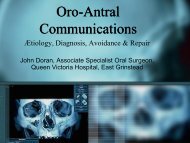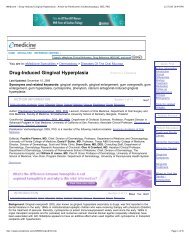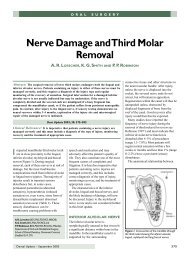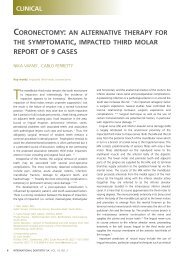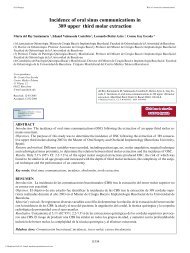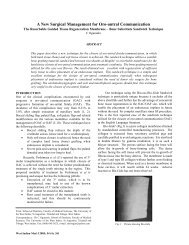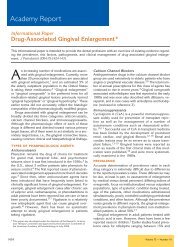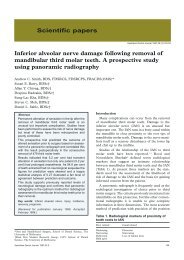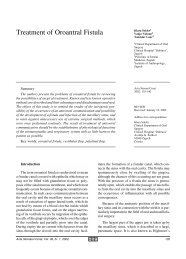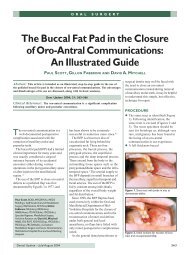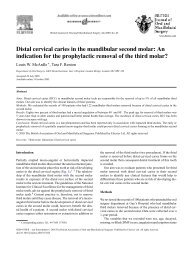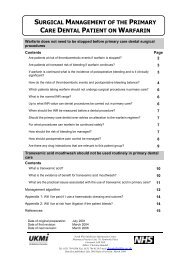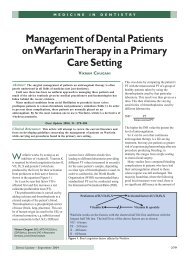Oral Surg Oral Med Oral Pathol Oral Radiol Endod 2004 - Surgical ...
Oral Surg Oral Med Oral Pathol Oral Radiol Endod 2004 - Surgical ...
Oral Surg Oral Med Oral Pathol Oral Radiol Endod 2004 - Surgical ...
You also want an ePaper? Increase the reach of your titles
YUMPU automatically turns print PDFs into web optimized ePapers that Google loves.
ORAL SURGERY ORAL MEDICINE ORAL PATHOLOGY<br />
Volume 97, Number 1<br />
radiation-associated xerostomia. 123-125 More recently, a<br />
number of double-blind and randomized, controlled<br />
trials have established that oral and perhaps high-dose<br />
topical pilocarpine may reduce the frequency and severity<br />
of radiation-induced xerostomia and associated<br />
symptoms. 126-131 More recently, 4 randomized, controlled<br />
trials were critically appraised, 3 of which used<br />
topical pilocarpine, and all reported subjective improvements<br />
in feelings of oral dryness, speaking, and<br />
chewing. 132 However, further evidence from other<br />
studies are needed before results can be generalized to<br />
the wider populations because the sample sizes in existing<br />
studies have varied and sampling methods were<br />
poorly defined.<br />
The optimal dosage of pilocarpine is 5 mg 4 times<br />
daily or 10 mg 3 times daily; the pilocarpine is well<br />
tolerated generally. The pilocarpine should be prescribed<br />
for at least 8 to 12 weeks, 131 but long-term use<br />
of this agent would be expected in that full recovery of<br />
salivary gland function after radiation is unlikely.<br />
Clinical benefit associated with oral pilocarpine may<br />
not always reflect salivary function before radiation or<br />
pilocarpine treatment. 131 Clinical response can vary<br />
between patients 110 and cannot be predicted with technetium<br />
99m pertechnetate scintigraphy, 133 but it is estimated<br />
that the majority of patients likely to have<br />
clinical benefit with pilocarpine will be identified during<br />
the first 12 weeks of therapy. 134 The pilocarpineinduced<br />
enhanced salivary secretion may be possible<br />
for up to 7 months after radiation, 135 and it has been<br />
suggested that the administration of pilocarpine before<br />
119 or during 136 the radiation may lessen the severity<br />
of any radiation-induced xerostomia.<br />
Pilocarpine cannot increase the function of glands<br />
that are completely damaged by irradiation, 128 but it<br />
does appear to enhance the function of minor salivary<br />
glands that may be more resistant to the damaging<br />
effects of radiation compared with the major glands.<br />
Indeed, by virtue of their location in relationship to the<br />
direction of the brachytherapy, the minor mucous salivary<br />
glands of the palate and elsewhere may escape the<br />
full dose of radiation. 134-137 Provided residual functioning<br />
salivary tissue exists, pilocarpine administered in<br />
the form of an oral spray may be effective in relieving<br />
symptoms of dry mouth, but further investigation is<br />
warranted. 137 However, it has been suggested that because<br />
of its limited efficacy and its adverse effects,<br />
other local treatments should be tried before the institution<br />
of topical pilocarpine. 138 A more recent study<br />
concluded that no beneficial effect on radiation-induced<br />
xerostomia is found when pilocarpine is administered<br />
during radiation for head and neck cancer. 139<br />
Pilocarpine in the management of SS. The results<br />
of initial placebo-controlled studies of relatively small<br />
Porter, Scully, and Hegarty 37<br />
numbers of patients with SS suggested that systemic<br />
pilocarpine increased salivary flow within 2 to 3 hours<br />
of administration and reduced symptoms of xerostomia.<br />
This clinical benefit of orally administered pilocarpine<br />
has been confirmed in a large randomized, placebocontrolled,<br />
fixed-dose multicenter trial. 140-142 As in the<br />
aforementioned studies of radiation-associated xerostomia,<br />
a dosage of 5 mg of pilocarpine 4 times daily for<br />
at least 12 weeks is clinically beneficial. Unstimulated<br />
salivary flow significantly increases 1 hour after the<br />
administration of 5 mg of pilocarpine. In addition to<br />
increasing whole saliva flow, pilocarpine can increase<br />
labial minor salivary gland secretion, 143 perhaps suggesting<br />
that many patients with SS have at least some<br />
potential to benefit clinically from treatment with cholinergic<br />
agonists.<br />
Pilocarpine therapy also reduced the frequency of<br />
oral and ocular symptoms related to xerostomia and<br />
xerophthalmia. These data suggest that pilocarpine may<br />
be of benefit in the symptomatic management of SS,<br />
but the studies have not included patients with absolute<br />
xerostomia, who may have the most severe oral symptoms<br />
of long-standing oral dryness.<br />
Pilocarpine therapy may reduce the oral carriage of<br />
Candida albicans in SS, 144 but this is unlikely to be of<br />
notable significance to the oral signs or symptoms of<br />
long-standing dry mouth. Likewise, the precise influence<br />
of pilocarpine upon salivary IgA and cytokine<br />
secretion (if at all relevant to the disease process)<br />
remains unclear. 145<br />
Pilocarpine for xerostomia associated with<br />
cGVHD. Pilocarpine is likely to be of benefit inthe<br />
management of xerostomia associated with cGVHD.<br />
The results of an open study suggested that orally<br />
administered pilocarpine reduced xerostomia-associated<br />
dysarthria and dysphagia in a small group of<br />
patients. 146-149 <strong>Oral</strong> pilocarpine (Salogen) 30 mg/day<br />
can alleviate cGVHD-induced xerostomia and improve<br />
the flow rate from the major salivary glands, resulting<br />
in the normalization of the altered salivary biochemical<br />
and immunologic composition in patients with<br />
cGVHD. 149<br />
Pilocarpine for drug-induced xerostomia. There<br />
have been few reports of the efficacy of pilocarpine<br />
in the management of drug-induced xerostomia.<br />
Early studies suggested that pilocarpine reduced the<br />
severity of xerostomia associated with antihypertensive<br />
and tricyclic antidepressant therapy, 112-115 but<br />
the results of a recent case report of antidepressantassociated<br />
oral dryness 150 and those of one animal<br />
study 151 suggest that pilocarpine is unlikely to be of<br />
benefit in the management of drug-induced xerostomia.<br />
However, the 2 adrenoceptor antagonist yohimbine<br />
has been shown to have a sialogenic effect



